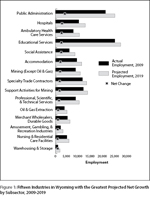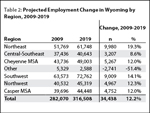Industry Projections: Growth Expected in Most Sectors
As the total number of jobs in Wyoming grows from 2009 to 2019, most industry sectors are projected to increase.
Wyoming is projected to add a net 34,438 jobs (12.2%) from 2009 to 2019 (see Table 1). The industry sectors projected to see the highest level of growth are health care & social assistance (9,895, or 30.6%), natural resources & mining (5,971, or 19.7%), public administration (4,566, or 18.8%), and leisure & hospitality (4,479, or 13.7%). Job losses are projected in the manufacturing (-1,438, or -15.1%), retail trade (-322, or -1.0%), and information (-168, or -3.6%) industries.
of growth are health care & social assistance (9,895, or 30.6%), natural resources & mining (5,971, or 19.7%), public administration (4,566, or 18.8%), and leisure & hospitality (4,479, or 13.7%). Job losses are projected in the manufacturing (-1,438, or -15.1%), retail trade (-322, or -1.0%), and information (-168, or -3.6%) industries.
The industries in this article are defined by the North American Industry Classification System (NAICS), which uses a 6-digit hierarchical coding system to classify all economic activity into 20 industry sectors. Five sectors are mainly goods-producing sectors and 15 are entirely services-producing sectors. NAICS allows for the identification of approximately 1,170 industries. An example of this can be seen in the related box on page 10, which shows the NAICS breakdown for the public administration industry. This industry consists of a variety of activities such as executive bodies, legislative offices, courts, police protection, fire protection, American Indian and Alaska Native tribal governments, and more (NAICS, 2007). 
Figure 1 shows the 15 industry subsectors that are projected to grow the most between 2009 and 2019. The subsectors with the largest projected growth rates include amusement, gambling, & recreation (45.4%, 1,226 jobs) and social assistance (38.3%, 2,620 jobs). The support activities for mining subsector is projected to grow by 4,201 jobs (36.7%) and ambulatory healthcare services is projected to grow by 2,944 jobs (33.5%). Employment in hospitals is projected to increase by 3,189 jobs (27.9%).
Job growth is projected in all regions of Wyoming (see Table 2).  The regions of the state with the highest levels of employment in the natural resources & mining and leisure & hospitality industries are projected to see the highest growth during this period. The Northeast region of Wyoming – which includes Campbell, Crook, Johnson, Sheridan, and Weston counties – is projected to add 9,980 jobs (19.3%). The Southwest region of the state – which includes Lincoln, Sublette, Sweetwater, Teton, and Uinta counties – is projected to add 9,009 jobs (14.1%).
The regions of the state with the highest levels of employment in the natural resources & mining and leisure & hospitality industries are projected to see the highest growth during this period. The Northeast region of Wyoming – which includes Campbell, Crook, Johnson, Sheridan, and Weston counties – is projected to add 9,980 jobs (19.3%). The Southwest region of the state – which includes Lincoln, Sublette, Sweetwater, Teton, and Uinta counties – is projected to add 9,009 jobs (14.1%).
The Northwest region – which includes Big Horn, Fremont, Hot Springs, Park, and Washakie counties – is projected to add 4,967 jobs (12.3%). The Central-Southeast Region – which is made up of Albany, Carbon, Converse, Goshen, and Platte counties – is projected to add 3,207 jobs (8.6%). The Cheyenne metropolitan statistical area (MSA) is projected to add 5,267 jobs (12.0%), while the Casper MSA is projected to add 4,752 (12.0%).
Emerging Technologies and Projections
These projections do not take into consideration new and emerging technologies that are likely to play an important role in Wyoming's economy over the next 10 years. As technology sectors such as wind energy, commercial carbon capture and sequestration, smart grid transmission, solar, and geothermal continue to be developed, new jobs likely will be created (Northern Plains and Rocky Mountain Consortium, 2011).
As each new technology develops, it will require jobs for construction, operation, and maintenance. In addition, regulatory jobs likely will be necessary to oversee the environmental impact of these new technologies.
More detailed information on projections for 2009 to 2019 is available online at http://doe.state.wy.us/LMI/projections.htm.
References
North American Industry Classification System. (2007). Retrieved June 21, 2011, from http://www.census.gov/eos/www/naics/
Northern Plains and Rocky Mountain Consortium. (2011). Researching the Green Economy: Final Summary Report. Retrieved June 22, 2011, from http://doe.state.wy.us/LMI/energy/
New_and_Emerging_Technologies_Report.pdf

